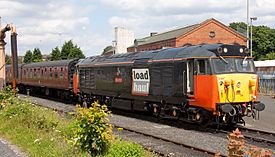Difference between revisions of "BR Class 50 50035 Ark Royal"
m (Hit save, not preview - whoops.) |
m (Diesel navbox) |
||
| Line 50: | Line 50: | ||
[[Diesel Locomotives]]<br> | [[Diesel Locomotives]]<br> | ||
[[List of preservation groups]] | [[List of preservation groups]] | ||
| + | |||
| + | {{DieselNavbox}} | ||
[[Category:Operational passenger hauling diesel locomotives]] | [[Category:Operational passenger hauling diesel locomotives]] | ||
Revision as of 23:15, 22 November 2016
| BRBritish Rail or British Railways Class 50 50035 Ark Royal | |
|---|---|
 50035 Ark Royal at Kidderminster | |
| Built By | English Electric Vulcan Foundry Works, Newton-le-Willows |
| Configuration | Co-Co |
| Power type | Diesel Electric |
| Status | In service |
| Loco Number | 50035 |
| Other Numbers | D435 |
| History | |
| Built | 1968 |
| Designed By | English Electric |
| Type | Class 50 |
| 1991 | Purchased by The 50 Fund |
| Technical | |
| Length | 68ft 6" |
| Weight | 115t |
50035 Ark Royal is a BRBritish Rail or British Railways Class 50 diesel locomotive.
BRBritish Rail or British Railways Class 50
Fifty English Electric Type 4The British Railways classification for diesel locomotives of 2000 bhp to 2999 bhp (later BRBritish Rail or British Railways Class 50) diesel locomotives were built by English Electric at their Vulcan Foundry Works plant in Newton-le-Willows between 1967 and 1968. When built they were numbered in the D4xx series. They later became BRBritish Rail or British Railways’s Class 50, being allocated TOPSTotal Operations Processing System, an American computer system adopted by BR from the late 1960s to number and manage rolling stock. numbers in the 50xxx series. The class was nicknamed “Hoovers” because of the distinctive sound of the inertial air-filters with which the locomotives were originally fitted.
Initially the locomotives were used to haul express passenger trains on the West Coast Main Line (WCML) between Crewe and Scotland; that section not then being electrified. This often entailed ‘Multiple Working’, with two locomotives under control of a single driver.
By 1974 the northern WCML had been electrified, and the Class 50 fleet was being transferred to BRBritish Rail or British Railways’s Western Region to work main line passenger services out of London Paddington.
The Class 50’s did not originally carry names, but in the late 1970s BRBritish Rail or British Railways agreed to their being named after Royal Navy vessels with notable records in the First and Second World Wars.
Withdrawal of the class began in the early 1990s.
50035 Ark Royal in Service
D435 entered service at Stoke in August 1968, having been built as English Electric Works No 3805/D1176.
In May 1973 D435 was transferred to Crewe, being re-numbered 50035 in March 1974. Following electrification of the WCML, 50031 moved to Plymouth Laira in December 1976 (following a brief spell at Bristol), moving again to London’s Old Oak Common in June 1980.
In January 1978, 50035 was named Ark Royal after HMS Ark Royal, a Royal Navy World War 2 aircraft carrier. Commissioned in 1938, HMS Ark Royal was sunk on 14 November 1941 after being torpedoed by German U-boat U-81.
50035 was withdrawn from service by BRBritish Rail or British Railways on 5th August 1990.
50035 Ark Royal in Preservation
50035 was the first Class 50 to be preserved, being acquired by The Fund and handed over by BRBritish Rail or British Railways at the 1991 Old Oak Common Open Day. Since acquisition 50035 has been a regular performer on the SVRSevern Valley Railway.
In recent years 50035 has been running in a fictitious Load Haul livery (see Wikimedia Commons photo above), but in 2015 it has been repainted into BRBritish Rail or British Railways blue livery.
Links
Class 50 Alliance web site
50 Fund web site (still maintained)
See also
Diesel Locomotives
List of preservation groups
| ||||||||||||||||||||||||||||||||||||||||||||||||||||||||||||||||||||||||